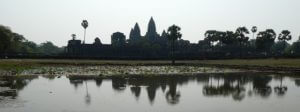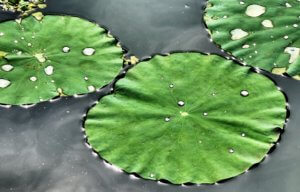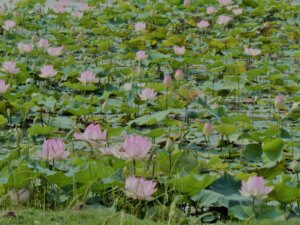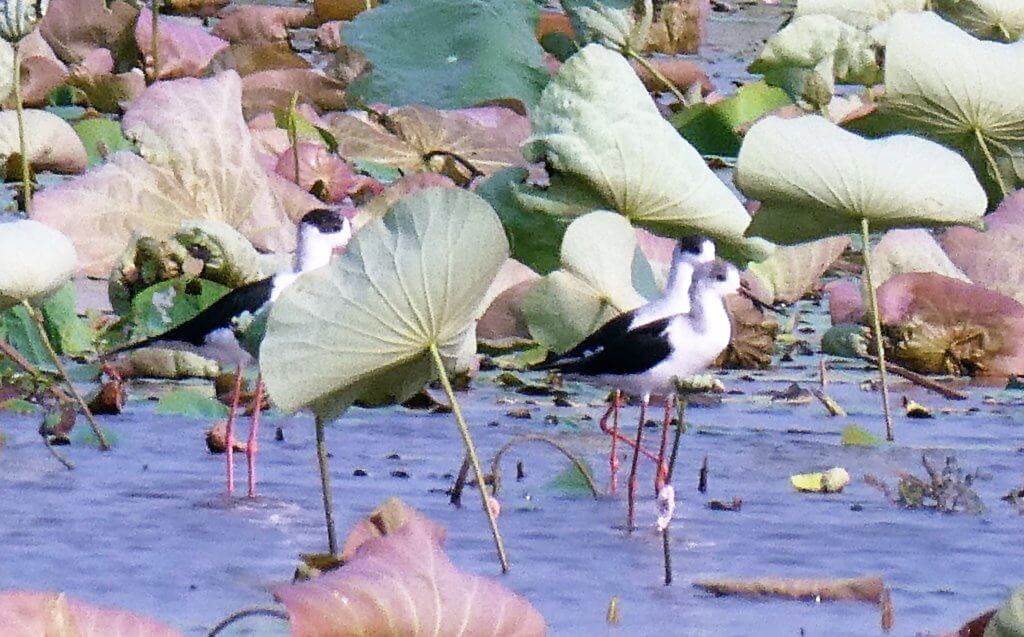Driving through the flood plain of the Mekong River from Siem Reap to Phnom Penh the countryside is flat and it’s been a rice growing area for millenia. Interspersed between the rice fields are the lotus ponds; the waving leaves of the lotus plants provide a contrasting dark green to the vivid green of the young rice plants – it looks like a wonderful mosaic carpet.
The lotus ponds are not just there for decoration as there is big business associated with the growing of the lotus plant. The flowers are picked when they are in bud and large bundles wrapped in the lotus plant leaves and taken to market in the early morning.

There, the ladies sit carefully folding the outer leaves of the buds inwards before selling them to Cambodians who take them as offerings to their pagodas or use them as decorations on the tables of restaurants, hotels and spas. When I first saw a bunch of lotus blossoms I was very puzzled by their appearance as the outer petals were folded – I couldn’t  believe they grew that way!
believe they grew that way!
The lotus flower symbolises many things in Buddhism. The lotus plant grows with its roots submerged in the muddy water of a lotus pond and the flowers are borne on tall stalks and unlike waterlilies they don’t float on the surface of the water but are held aloft above the water surface. For this reason they represent the struggle of mankind to seek the right path through life and the fully opened lotus flower symbolizes the achievement of full enlightenment. The colour is also significant. The pink lotus blossom is said to represent the Buddha himself and the white blossom represents purity.
 The lotus has also played a very important part in the architecture of the Angkor Dynasty, Angkor Wat being the most well-known example. The five towers represent five lotus buds and many of the other temples have similar “lotus” inspired towers.
The lotus has also played a very important part in the architecture of the Angkor Dynasty, Angkor Wat being the most well-known example. The five towers represent five lotus buds and many of the other temples have similar “lotus” inspired towers.
 The leaves of the lotus are really fascinating as leaves of Nelumbo spp. (along with a number of other plant species) exhibit self-cleaning properties due to their ultrahydrophobicity. What this means is that the architecture of the leaf surface minimizes water droplet adhesion. This is an excellent attribute for plant leaves as the water droplets gather and remove potential pathogens such as fungal spores and algae! Scientists observing this phenomenon in the lotus leaf mimicked the effect in the laboratory to produce water-repellent coatings used on fabrics, the hulls of ships to reduce drag and many other industrial uses.
The leaves of the lotus are really fascinating as leaves of Nelumbo spp. (along with a number of other plant species) exhibit self-cleaning properties due to their ultrahydrophobicity. What this means is that the architecture of the leaf surface minimizes water droplet adhesion. This is an excellent attribute for plant leaves as the water droplets gather and remove potential pathogens such as fungal spores and algae! Scientists observing this phenomenon in the lotus leaf mimicked the effect in the laboratory to produce water-repellent coatings used on fabrics, the hulls of ships to reduce drag and many other industrial uses.
The flowers apart, every part of the lotus plant is edible, the rhizomes, stems, flowers and seeds. A familiar sight in towns is to see the ladies cycling in with baskets of the seed pods for sale. The seeds which look like big peas can be eaten raw or cooked and do taste like raw peas. The stems and roots can be cooked and incorporated into a number of dishes, fried with ginger and onions is a popular dish.

Lotus ponds also attract many visitors for a place to just chill out and admire their beauty. At the lotus ponds outside Siem Reap there are numerous small huts which have been erected for people to come and relax in a hammock, eat a meal, drink a few beers and just gaze out over the waving lotus and watch the jacanas, black-winged stilts and pied kingfishers who inhibit this area too.
I’m going to miss the lotus ponds amongst the many, many other things which have made life in Cambodia such an interesting experience. I’m signing off now and heading to the airport…

©Copyright overthehils.com 2018


Beautiful! I am going to miss your blogs, you have taught me a lot. Enjoy being at home! Xxoo
Thanks Lynda – will continue to write as I settle into my new life!xx